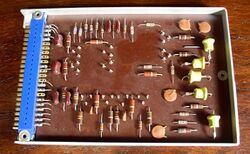Difference between revisions of "PDP-6"
(Ok fine, JOSS II.) |
(Move console photo to top; + a few words about its arch) |
||
| Line 21: | Line 21: | ||
}} | }} | ||
| − | [[Image: | + | [[Image:Tk-pdp6-cropped.jpeg|thumb|left|400px|The [[MIT_Artificial_Intelligence_Laboratory|MIT AI lab]] PDP-6 console]] |
| − | The '''PDP-6''' was effectively the first model of the [[PDP-10]]; they are (mostly) | + | The '''PDP-6''' was effectively the first model of the [[PDP-10]]; they are (mostly) [[object code]] compatible. It was built out of [[System Module]]s, [[DEC]]'s predecessor to the [[FLIP CHIP]] module series (out of which the first [[PDP-10]], the [[KA10]], was built). |
| − | [[ | + | It featured 36-[[bit]] [[word]]s, at the time effectively the standard for machines used for scientific computing. In a period when almost all [[program]]ming was done in [[assembly language]], it used those long words to provide a powerful and regular [[instruction set]]. |
| − | + | [[Image:PDP-6 mod top.jpg|thumb|left|250px|A System Module used in a [[PDP-6]]; this example has had its [[transistor]]s salvaged from it]] | |
| − | According to Tim Anderson, the Project MAC group Dynamic Modeling/Computer Graphics took delivery of the very last PDP-6 from a previous owner. They adopted the AI Lab's [[Incompatible Timesharing System|ITS]] [[operating system]], but shortly after moved onto a | + | The machine was not a success, commercially (only 23 were sold), in part because the hardware was unreliable - largely because of one type of large System Module, which contained one bit of the entire [[ALU]] section of the [[CPU]] - a 'bridge too far' at the then-current state of [[printed circuit board]] technology. |
| + | |||
| + | According to Tim Anderson, the Project MAC group Dynamic Modeling/Computer Graphics took delivery of the very last PDP-6 from a previous owner. They adopted the AI Lab's [[Incompatible Timesharing System|ITS]] [[operating system]], but shortly after moved onto a PDP-10. | ||
==External links== | ==External links== | ||
| + | * [http://bitsavers.org/pdf/dec/pdp6 PDP-6] - Bitsavers material on PDP-6 (fairly extensive) | ||
* [http://ed-thelen.org/comp-hist/pdp-6.html PDP-6] | * [http://ed-thelen.org/comp-hist/pdp-6.html PDP-6] | ||
* [http://www.decodesystems.com/pdp6.html The DEC PDP-6 Time-Sharing Computer] | * [http://www.decodesystems.com/pdp6.html The DEC PDP-6 Time-Sharing Computer] | ||
* [http://www.ultimate.com/phil/pdp10/pdp6-serials.html DEC PDP-6 Serial numbers] | * [http://www.ultimate.com/phil/pdp10/pdp6-serials.html DEC PDP-6 Serial numbers] | ||
| − | |||
* [https://github.com/aap/pdp6 Simulator based on processor schematics] | * [https://github.com/aap/pdp6 Simulator based on processor schematics] | ||
Revision as of 10:50, 11 January 2022
| PDP-6 | |
| Manufacturer: | Digital Equipment Corporation |
|---|---|
| Architecture: | PDP-10 |
| Year Design Started: | March, 1963 |
| Year First Shipped: | June, 1964 |
| Year Discontinued: | 1965 |
| Form Factor: | small mainframe |
| Word Size: | 36 bits |
| Logic Type: | germanium and silicon transistors |
| Design Type: | asynchronous with hardware subroutines |
| Clock Speed: | 4 μsec (approximately - different instructions take different amounts of time, the CPU is not synchronous) |
| Memory Speed: | 5 μsec (inital), 2 μsec (later) |
| Physical Address Size: | 18 bits |
| Virtual Address Size: | 18 bits |
| Memory Management: | single base and bounds register pair |
| Operating System: | Monitor, ITS, WAITS, JOSS II |
| Predecessor(s): | None |
| Successor(s): | KA10 |
| Price: | US$120K (CPU), US$300K (system) |

The PDP-6 was effectively the first model of the PDP-10; they are (mostly) object code compatible. It was built out of System Modules, DEC's predecessor to the FLIP CHIP module series (out of which the first PDP-10, the KA10, was built).
It featured 36-bit words, at the time effectively the standard for machines used for scientific computing. In a period when almost all programming was done in assembly language, it used those long words to provide a powerful and regular instruction set.
The machine was not a success, commercially (only 23 were sold), in part because the hardware was unreliable - largely because of one type of large System Module, which contained one bit of the entire ALU section of the CPU - a 'bridge too far' at the then-current state of printed circuit board technology.
According to Tim Anderson, the Project MAC group Dynamic Modeling/Computer Graphics took delivery of the very last PDP-6 from a previous owner. They adopted the AI Lab's ITS operating system, but shortly after moved onto a PDP-10.
External links
- PDP-6 - Bitsavers material on PDP-6 (fairly extensive)
- PDP-6
- The DEC PDP-6 Time-Sharing Computer
- DEC PDP-6 Serial numbers
- Simulator based on processor schematics
